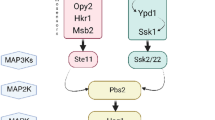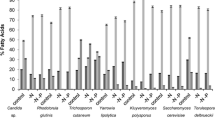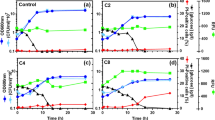Abstract
Using chemical mutagenesis, mutants of Hansenula polymorpha that were defective in fatty acid synthesis were selected based on their growth requirements on saturated fatty acid mixtures. One mutant (S7) was incapable of synthesizing polyunsaturated fatty acids (PUFA), linoleic and α-linolenic acids. A genetic analysis demonstrated that the S7 strain had a double lesion affecting fatty acid synthesis and Δ12-desaturation. A segregant with a defect in PUFA synthesis (H69-2C) displayed normal growth characteristics in the temperature range of 20–42 °C through a modulation of the cellular fatty acid composition. Compared with the parental strain, this yeast mutant had increased sensitivity at low and high temperatures (15 and 48 °C, respectively) with an increased tolerance to oxidative stress. The responses to ethanol stress were similar for the parental and PUFA-defective strains. Myristic acid was also determined to play an essential role in the cell growth of H. polymorpha. These findings suggest that both the type of cellular fatty acids and the composition of fatty acids might be involved in the stress responsive mechanisms in this industrially important yeast.





Similar content being viewed by others
References
Hodgkin MA, Sudbery PE, Kerry-Williams S, Goodey A (1990) Secretion of human serum albumin from Hansenula polymorpha. Yeast 6S:435
Gellissen G, Janowicz ZA, Merckelbach A, Piontek M, Keup P, Weydemann U, Hollenberg CP, Strasser AWM (1992) Heterologous gene expression in Hoansneula polymrpha: efficient secretion of glucoamylase. Bio/Technology 9:291–295
Schaefer S, Piontek M, Ahn S-J, Papendieck A, Janowicz ZA, Gellissen G (2001) Recombinant hepatitis B vaccines-characterization of the viral disease and vaccine production in the methylotrophic yeast Hansenula polymorpha. In: Dembowsky K, Stadler P (eds) Novel therapeutic proteins: selected case studies. Wiley, Weinheim, pp 245–276
Ryabova OB, Chmil OM, Sibirny AA (2003) Xylose and cellobiose fermentation to ethanol by the thermotolerant methylotrophic yeast Hansenula polymorpha. FEMS Yeast Res 4:157–164
Ishchuk OP, Voronovsky AY, Abbas CA, Sibirny AA (2009) Construction of Hansenula polymorpha strains with improved thermotolerance. Biotechnol Bioeng 104:911–919
Grabek-Lejko D, Kurylenko OO, Sibirny VA, Ubiyvovk VM, Penninckx M, Sibirny AA (2011) Alcoholic fermentation by wild-type Hansenula polymorpha and Saccharomyces cerevisiae versus recombinant strains with an elevated level of intracellular glutathione. J Ind Microbiol Biotechnol 38:1853–1859
Vigh L, Maresca B, Harwood JL (1998) Does the membrane’s physical state control the expression of heat shock and other genes? Trends Biochem Sci 23:369–374
Vigh L, Escriba PV, Sonnleitner A, Sonnleitner M, Piotto S, Maresca B, Horva′th I, Harwood JL (2005) The significance of lipid composition for membrane activity: new concepts and ways of assessing function. Prog Lipid Res 44:303–344
Cheawchanlertfa P, Cheevadhanarak S, Tanticharoen M, Maresca B, Laoteng K (2011) Up-regulated expression of desaturase genes of Mucor rouxii in response to low temperature associates with pre-existing cellular fatty acid constituents. Mol Biol Rep 38:3455–3462
Kajiwara S, Shirai A, Fujii T, Toguri T, Nakamura K, Ohtaguchi K (1996) Polyunsaturated fatty acid biosynthesis in Saccharomyces cerevisiae: expression of ethanol tolerance and the FAD2 gene from Arabidopsis thaliana. Appl Environ Microbiol 62:4309–4313
Rodriguez-Vargas S, Sanchez-Garcia A, Martinez-Rivas JM, Prieto JA, Randez-Gil F (2007) Fluidization of membrane lipids enhances the tolerance of Saccharomyces cerevisiae to freezing and salt stress. Appl Environ Microbiol 73:110–116
Cipak A, Jaganjac M, Tehlivets O, Kohlwein SD, Zarkovic N (2008) Adaptation to oxidative stress induced by polyunsaturated fatty acids in yeast. Biochim Biophys Acta 1781:283–287
Yazawa H, Iwahashi H, Kimura K, Kamisaka Y, Uemura H (2009) Production of polyunsaturated fatty acids in yeast Saccharomyces cerevisiae and its relation to alkaline pH tolerance. Yeast 26:167–184
Cipak A, Hasslacher M, Tehlivets O, Collinson EJ, Zivkovic M, Matijevic T, Wonisch W, Waeg G, Dawes IW, Zarkovic N, Kohlwein SD (2006) Saccharomyces cerevisiae strain expressing a plant fatty acid desaturase produces polyunsaturated fatty acids and is susceptible to oxidative stress induced by lipid peroxidation. Free Radic Biol Med 40:897–906
Ruenwai R, Neiss A, Laoteng K, Vongsangnak W, Dalfard AB, Cheevadhanarak S, Petranovic D, Nielsen J (2011) Heterologous production of polyunsaturated fatty acids in Saccharomyces cerevisiae causes a global transcriptional response resulting in reduced proteasomal activity and increased oxidative stress. Biotechnol J 6:343–356
Anamnart S, Tolstorukov I, Kaneko Y, Harashima S (1998) Fatty acid desaturation in methylotrophic yeast Hansenula polymorpha strain CBS1976 and unsaturated fatty acid auxotrophic mutants. J Ferment Bioeng 85:476–482
Gleeson MA, Sudbery PE (1988) Genetic analysis in the methylotrophic yeast Hansenula polymorpha. Yeast 4:293–303
Kyte J, Doolittle RR (1982) A simple method for displaying the hydropathic character of a protein. J Mol Biol 157:105–132
Saitou N, Nei M (1987) The neighbor-joining method: a new method for reconstructing phylogenetic trees. Mol Biol Evol 4:406–425
Tamura K, Peterson D, Peterson N, Stecher G, Nei M, Kumar S (2011) MEGA5: molecular evolutionary genetics analysis using maximum likelihood, evolutionary distance, and maximum parsimony methods. Mol Biol Evol 28:2731–2739
Felsenstein J (1985) Confidence limits on phylogenies: an approach using the bootstrap. Evolution 39:783–791
Haan GJ, van Dijk R, Kiel JAKW, Veenhuis M (2001) Characterization of the Hansenula polymorpha PUR7 gene and its use as selectable marker for targeted chromosomal integration. FEMS Yeast Res 2:17–24
Stearns T, Ma H, Botstein D (1990) Manipulating yeast genome using plasmid vectors. Methods Enzymol 185:280–297
Lepage G, Roy CC (1984) Improved recovery of fatty acid through direct transesterification without prior extraction or purification. J Lipid Res 25:1391–1396
Sakamoto T, Wada H, Nishida I, Ohmori M, Murata N (1994) Identification of conserved domains in the delta 12 desaturases of cyanobacteria. Plant Mol Biol 24:643–650
Sakuradani E, Kobayashi M, Ashikari T, Shimizu S (1999) Identification of delta 12-fatty acid desaturase from arachidonic acid-producing Mortierella fungus by heterologous expression in the yeast Saccharomyces cerevisiae and the fungus Aspergillus oryzae. Eur J Biochem 261:812–820
Wei D, Li M, Zhang X, Ren Y, Xing L (2004) Identification and characterization of a novel delta 12-fatty acid desaturase gene from Rhizopus arrhizus. FEBS Lett 573:45–50
Wei DSh, Li MCh, Zhang XX, Zhou H, Xing LJ (2006) A novel delta 12-fatty acid desaturase gene from methylotrophic yeast Pichia pastoris GS115. Acta Biochim Pol 53:753–759
Wright MH, Heal WP, Mann DJ, Tate EW (2010) Protein myristoylation in health and disease. J Chem Biol 3:19–35
Duronio RJ, Rudnick DA, Johnson RL, Linder ME, Gordon JI (1991) Myristic acid auxotrophy caused by mutation of Saccharomyces cerevisiae myristoyl-CoA: protein N-myristoyltransferase. J Cell Biol 113:1313–1330
Duronio RJ, Knoll LJ, Gordon JI (1992) Isolation of a Saccharomyces cerevisiae long chain fatty acyl: CoA synthetase gene (FAA1) and assessment of its role in protein N-myristoylation. J Cell Biol 117:515–529
Johnson DR, Knoll LJ, Levin DE, Gordon JI (1994) Saccharomyces cerevisiae contains four fatty acid activation (FAA) genes: an assessment of their role in regulating protein N-myristoylation and cellular lipid metabolism. J Cell Biol 127:751–762
Nakagawa Y, Sakumoto N, Kaneko Y, Harashima S (2002) Mga2p is a putative sensor for low temperature and oxygen to induce OLE1 transcription in Saccharomyces cerevisiae. Biochem Biophys Res Commun 291:707–713
Alexandre H, Rousseaux I, Charpentier C (1994) Ethanol adaptation mechanisms in Saccharomycescerevisiae. Biotechnol Appl Biochem 20:173–183
Piper PW (1995) The heat shock and ethanol stress responses of yeast exhibit extensive similarity and functional overlap. FEMS Microbiol Lett 134:121–127
Peyou-Ndi MM, Watts JL, Browse J (2000) Identification and characterization of an animal Δ12 fatty acid desaturase gene by heterologous expression in Saccharomyces cerevisiae. Arch Biochem Biophys 376:399–408
Xiao D, Wu S, Zhu X, Chen Y, Guo X (2010) Effects of soya fatty acids on cassava ethanol fermentation. Appl Biochem Biotechnol 160:410–420
Laoteng K, Jitsue S, Dandusitapunth Y, Cheevadhanarak S (2008) Ethanol-induced changes in expression profiles of cell growth, fatty acid and desaturase genes of Mucor rouxii. Fungal Genet Biol 45:61–67
Berlett BS, Stadtman ER (1997) Protein oxidation in aging, disease, and oxidative stress. J Biol Chem 272:20313–20316
Costa V, Moradas-Ferreira P (2001) Oxidative stress and signal transduction in Saccharomyces cerevisiae: insights into ageing, apoptosis and diseases. Mol Aspects Med 22:217–246
Acknowledgments
This work was funded by a Grant from Office of National Research Council of Thailand. We are grateful to Prof. Amorn Petsom for his critical comment on this study. We also thank Tayvich Vorapreeda for helping in figure preparation.
Author information
Authors and Affiliations
Corresponding author
Electronic supplementary material
Below is the link to the electronic supplementary material.
Rights and permissions
About this article
Cite this article
Sooksai, S., Chewchanlertfa, P., Kaneko, Y. et al. Alterations in growth and fatty acid profiles under stress conditions of Hansenula polymorpha defective in polyunsaturated fatty acid synthesis. Mol Biol Rep 40, 4935–4945 (2013). https://doi.org/10.1007/s11033-013-2594-3
Received:
Accepted:
Published:
Issue Date:
DOI: https://doi.org/10.1007/s11033-013-2594-3




